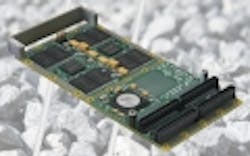Electronics thermal management is big issue for land vehicles and spacecraft
HACKETTSTOWN, N.J., 3 Oct. 2010.Electronics cooling and electronics thermal management have become the biggest challenge for military electronics due to: significantly increased power levels, more severe environments, and condensed schedules with a desire for COTS, explains Mike Henderson, director, military and aerospace products at TDI Power in Hackettstown, N.J.
“Regardless of whether it’s an aircraft, vehicle, or shipboard application, the power loads for new command, control, and communications (C3) systems, counter-weapon systems, and other applications being developed are driving the need for better thermal management,” Henderson says. “More power means more heat, which has to be dissipated and managed efficiently. In addition, you have traditionally non-electric, belt driven systems being electrified to improve reliability and lower the overall weight of the particular platform. Very simply, without innovative thermal management techniques for power electronics, the military will not be able to field the new systems or hybrid platforms currently being developed.”
Environmental conditions for electronics are getting worse; mil-aero systems are exposed to water egress, blowing talcum-powder-like sand, high levels of shock and vibration, and operating temperatures that range from Arctic conditions as low as -46 degrees C to in excess of 149 degrees C near engines that are dissipating very high levels of heat. In the latter situation, “we actually have to insulate the power electronics to keep heat out,” Henderson reveals. “In these conditions, simple convection cooling using blown air is just not an option, as the fans would have to be very large and noisy blowing contaminants that would quickly render them useless, thus disabling the very systems they were meant to cool.”
TDI Power’s DC-DC or DC-AC products, employed in military ground vehicles, are typically mounted below the fording plane, which means the power electronics must be completed sealed. Liquid cooling is the only feasible way to cool such high-power products that can be upwards of 30 kilowatts, Henderson says. The company’s LiquaCore technology employs liquid cooling from the vehicle’s coolant system to dissipate heat away from sensitive electronics in a modular, scalable architecture. A typical LiquaCore module “wraps” the electronics in a cold plate through which cooling liquid is flowing in multiple, parallel passageways. Power semiconductors, magnetics, and PC boards come in direct contact with the liquid-cooled metal housing for maximum cooling efficiency.
The ability to cool electronics with a water/glycol mix at a typical temperature of 80 degrees C enables TDI Power engineers to use materials already present on the vehicle and to avoid the addition of relatively unreliable fans or heavy, heat-dissipating plates, Henderson explains. “With LiquaCore, we can quickly configure a power solution using standard modules in a customized outer skin that meets the end users’ available space claim. For example, the power conversion system can easily be mounted in the V-shaped undercarriage of vehicles like MRAPs (Mine Resistant Ambush Protected vehicles).” A power-conversion system configured with LiquaCore modules is also well suited for hybrid or all-electric vehicles in which tightly regulated DC power is needed for on-vehicle applications or AC power is required to meet off-vehicle needs.
Hot under the collar
Soldiers and soldier borne electronics, especially those deployed in desert environments, require innovative and exceedingly compact and efficient thermal management tactics. Engineers at RINI Technologies Inc. in Oviedo, Fla., have developed a miniature refrigeration product weighing less than 4 pounds.
The primary application for the refrigeration unit is personal cooling, yet it has been adapted to cool small lasers and electronic modules operating in hot military environments. “When a laser or electronics module is unable to operate in hot environments, our technology is increasingly one of the only solutions to provide the needed cooling without exceeding typically strict size and weight budgets,” says Dr. Daniel P. Rini, president of RINI Technologies.
Frigid, final frontier
Space represents a very challenging environment for electronics, considering its extreme thermal conditions, radiation hazards, costly and remote maintenance, and so on. Technology firms continue to innovate in an effort to warm electronics in the absence of solar heat and to shield systems from the intense heat emitted from rocket motors.
Engineers at NASA’s Jet Propulsion Laboratory (JPL) sought the most efficient and maintenance-free methods to dissipate heat from the Moon Mineralogy Mapper’s (M3’s) sensitive electronics, which enable the instrument to identify lunar minerals from orbit 100 kilometers above the moon’s surface. Staff at the k Technology Division of Thermacore Inc. in Langhorne, Pa., helped JPL engineers not only develop thermal specifications for optimum rejection of high heat loads from the M3, but also design a system that would work without the need for maintenance or adjustments.
Thermacore also delivered six radiator panels, featuring the company’s patented k-Core advanced, high-conduction composites to reject excess heat into space. Thermal straps, also fabricated by Thermacore’s k Technology Division, were used as heat spreaders within the instrument. In addition, k Technology team members tested the completed components to ensure compliance with performance objectives, such as meeting the most rigorous specifications in the unique environment of outer space.
